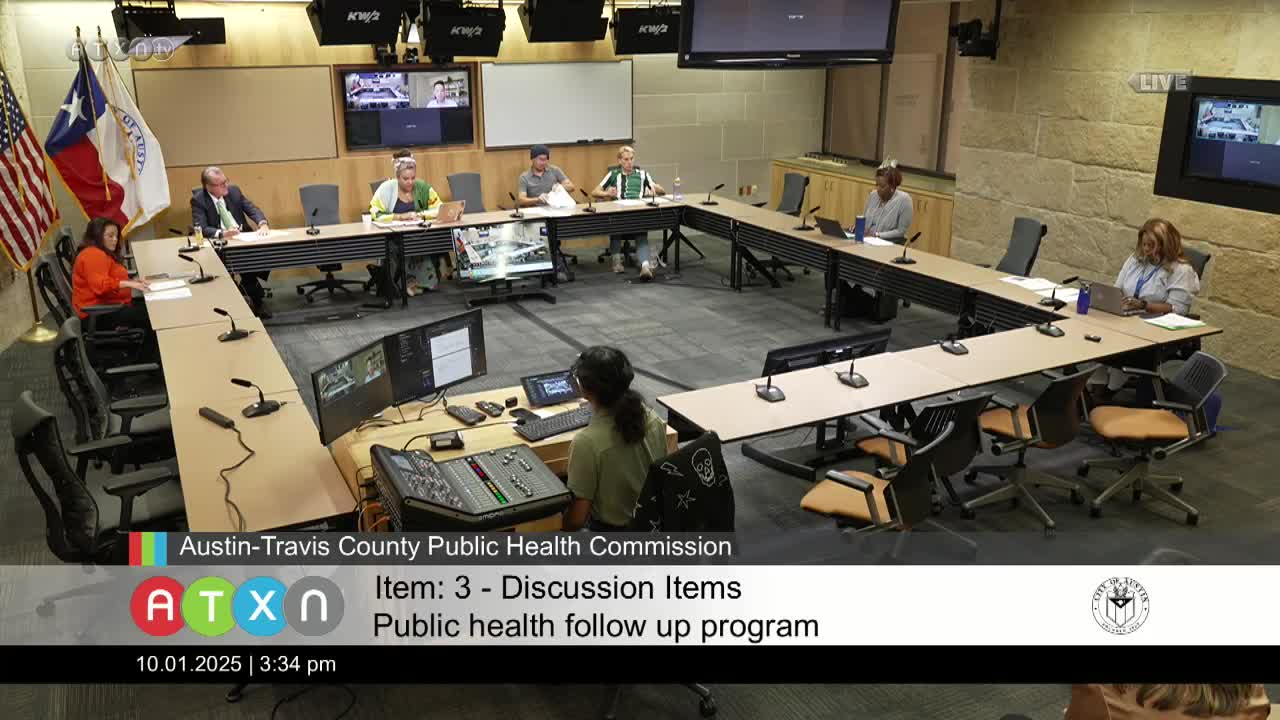Public Health Commission debates prioritizing core public-health services, funding and transportation needs
October 01, 2025 | Austin, Travis County, Texas
This article was created by AI summarizing key points discussed. AI makes mistakes, so for full details and context, please refer to the video of the full meeting. Please report any errors so we can fix them. Report an error »

The Austin-Travis County Public Health Commission devoted an extended agenda segment to discussing priorities for the next six months and possible areas for action, including whether to emphasize core public-health services or broader human-services issues tied to social determinants of health.
Commissioners and staff framed several potential paths: (1) policy and budget advocacy to secure local funding for public health services; (2) convening or partnering with external community institutions (philanthropy, United Way) to address larger social determinants; (3) targeted, implementable campaigns such as provider education, signage or public-awareness efforts; and (4) infrastructure opportunities in upcoming bond proposals to embed public-health functions in new neighborhood centers.
Director Sturrup (referred to in the transcript as the department director) said programmatic capacity exists but that the department needs resources and policy support to address root causes. Commissioners suggested drafting high-level recommendations (for example, a funding target for the city public-health budget) rather than prescribing programmatic details, leaving implementation design to departmental staff. One commissioner suggested a recommendation to increase the city's public-health allocation (for example, a stated percentage of the city budget) as a high-level advocacy item; staff noted such a recommendation would apply to the City of Austin public-health department and not to separate taxing entities such as Central Health or Travis County.
Transportation and access to services were recurring topics. Commissioners discussed the potential to include clinic-related transportation priorities in city or bond planning and the role of Capital Metro; they noted that Capital Metro is an independent entity and suggested partnership or advocacy rather than assuming any single funding vehicle. Commissioners proposed that bond-funded neighborhood centers could include space for public-health functions (WIC, immunizations, CHW workspace) and that commission advocacy now could influence whether APH services are embedded in planned infrastructure.
Several commissioners recommended focusing the commission's energy on policy and resourcing requests (for example, advocating for APH funding in the budget or for bond allocations) and on convening partners rather than drafting detailed program designs. Commissioners also discussed using CHWs and community partnerships for education and outreach, and the potential to work with medical societies and local providers on testing and prevention campaigns (for example, syphilis screening and maternal-health outreach).
No formal motion or vote resulted from the discussion; commissioners instructed staff to draft potential recommendations and timeline items for future meetings, and several commissioners volunteered to develop draft language and to coordinate with staff for the November and December schedule (including a December retreat to finalize a six-month work plan).
Commissioners and staff framed several potential paths: (1) policy and budget advocacy to secure local funding for public health services; (2) convening or partnering with external community institutions (philanthropy, United Way) to address larger social determinants; (3) targeted, implementable campaigns such as provider education, signage or public-awareness efforts; and (4) infrastructure opportunities in upcoming bond proposals to embed public-health functions in new neighborhood centers.
Director Sturrup (referred to in the transcript as the department director) said programmatic capacity exists but that the department needs resources and policy support to address root causes. Commissioners suggested drafting high-level recommendations (for example, a funding target for the city public-health budget) rather than prescribing programmatic details, leaving implementation design to departmental staff. One commissioner suggested a recommendation to increase the city's public-health allocation (for example, a stated percentage of the city budget) as a high-level advocacy item; staff noted such a recommendation would apply to the City of Austin public-health department and not to separate taxing entities such as Central Health or Travis County.
Transportation and access to services were recurring topics. Commissioners discussed the potential to include clinic-related transportation priorities in city or bond planning and the role of Capital Metro; they noted that Capital Metro is an independent entity and suggested partnership or advocacy rather than assuming any single funding vehicle. Commissioners proposed that bond-funded neighborhood centers could include space for public-health functions (WIC, immunizations, CHW workspace) and that commission advocacy now could influence whether APH services are embedded in planned infrastructure.
Several commissioners recommended focusing the commission's energy on policy and resourcing requests (for example, advocating for APH funding in the budget or for bond allocations) and on convening partners rather than drafting detailed program designs. Commissioners also discussed using CHWs and community partnerships for education and outreach, and the potential to work with medical societies and local providers on testing and prevention campaigns (for example, syphilis screening and maternal-health outreach).
No formal motion or vote resulted from the discussion; commissioners instructed staff to draft potential recommendations and timeline items for future meetings, and several commissioners volunteered to develop draft language and to coordinate with staff for the November and December schedule (including a December retreat to finalize a six-month work plan).
View full meeting
This article is based on a recent meeting—watch the full video and explore the complete transcript for deeper insights into the discussion.
View full meeting
